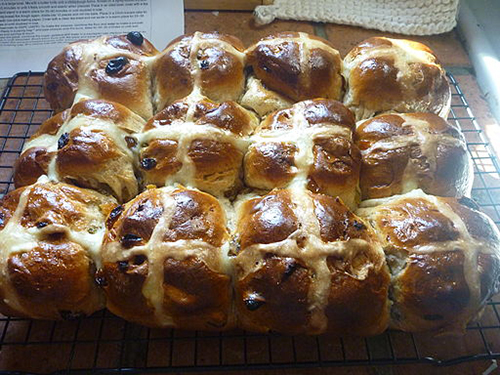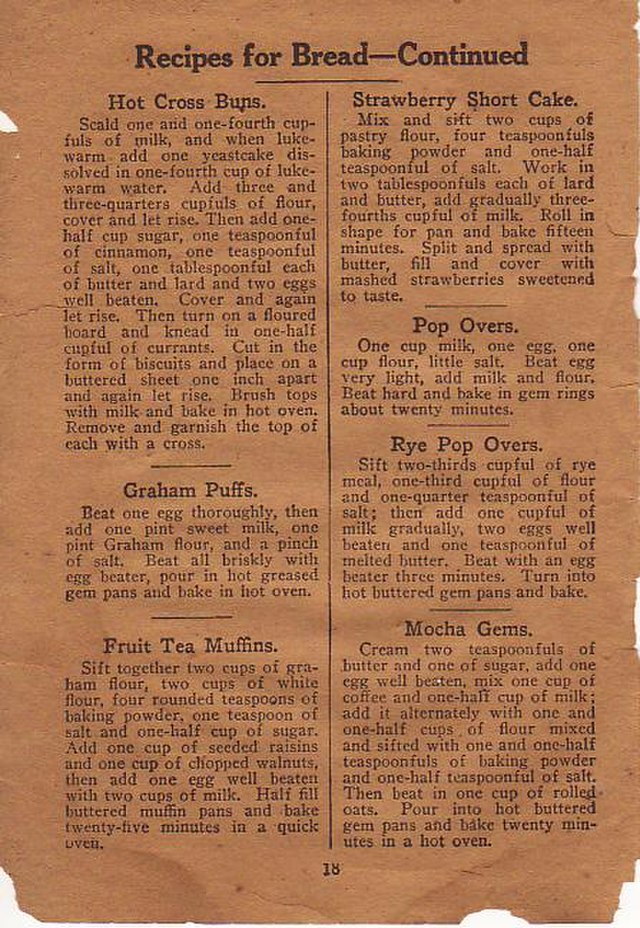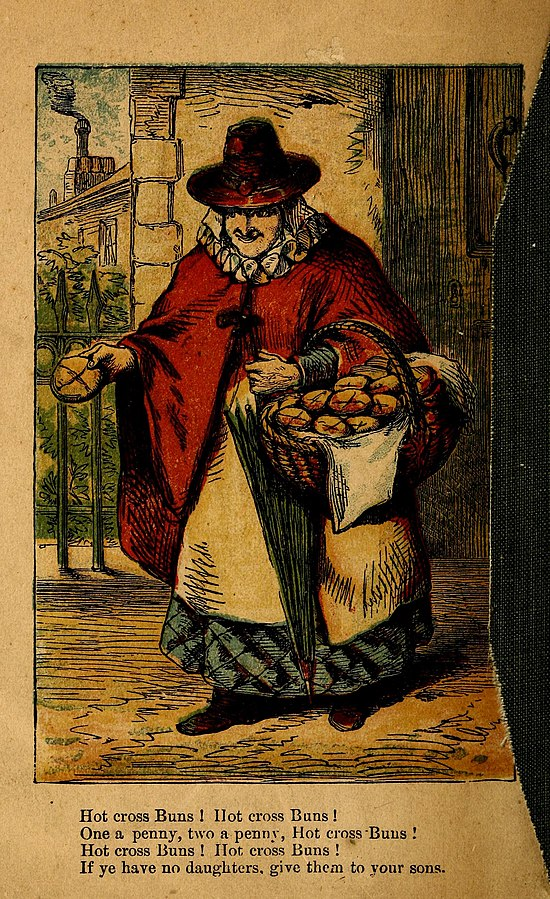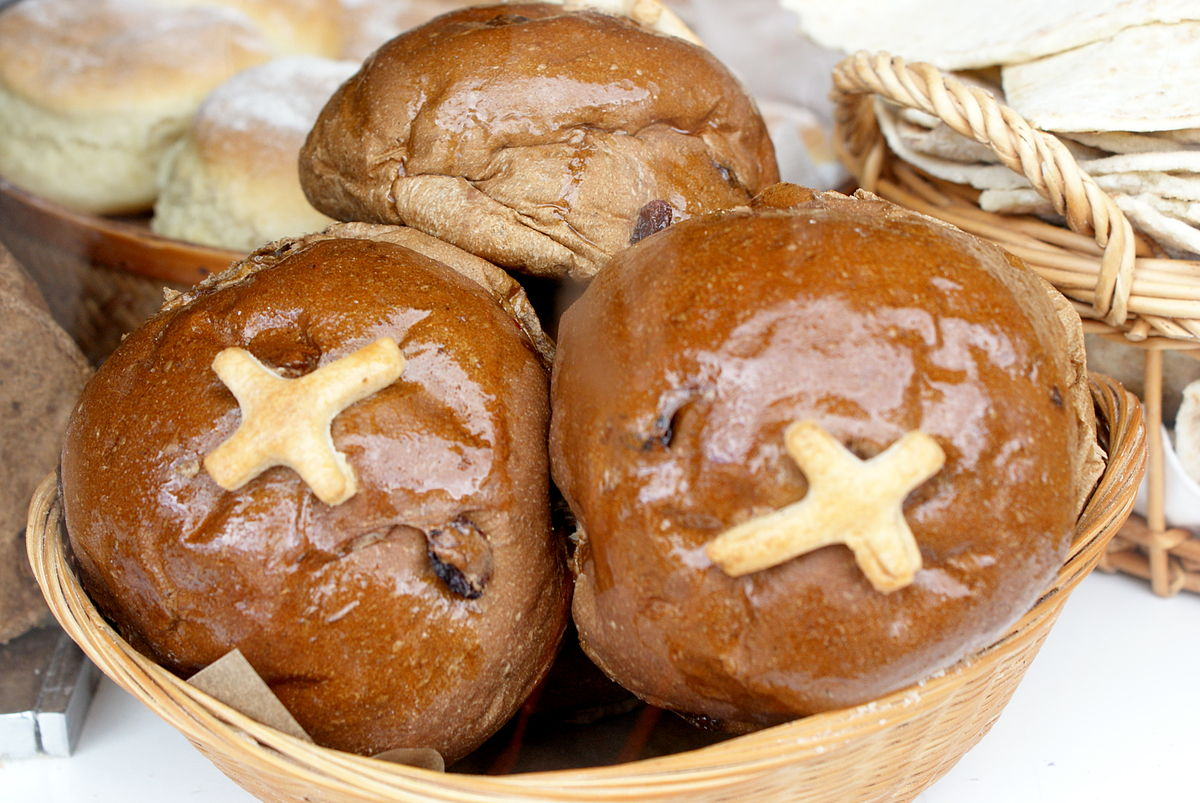Go to Devons Road in London in Bromley-by-Bow and you’ll find a pub with a net of hot cross buns hanging above the bar.
I know, it’s pretty weird – even for a pub. But a legend has grown up around The Widow’s Son. Every year, a sailor arrives on Good Friday and places a hot cross bun in the nets over the bar.
But why? Let’s explore this legend in this week’s article!
The Original Legend
According to the story, a widow’s house originally stood on the site now occupied by the pub. Her sailor son spent much of the year at sea, but one year she expected him home at Easter. He promised to return on Good Friday.
She baked him a hot cross bun and set it aside when he didn’t return that day. Perhaps she expected him soon after.

But her son didn’t return that Easter. So the following year she did the same thing. She baked a batch of hot cross buns and set one aside for her son.
The custom continued and every year she added another unclaimed bun to the pile. Her house became famous for the growing collection of hot cross buns.
Some accounts name her as Mrs Hart and she apparently died in 1813. Meanwhile, another article named her as Mrs Brodie (Dundee Courier 1910: 3). According to one version of the legend, the sailor wrote home in 1788 to ask her to save a bun for him (Alexander 2005). If that’s true, then she kept saving hot cross buns for another 25 years. According to Tatler, the tradition dated to 1824 (Tatler 1966: 4).

In 1958, a sailor from Bow hung up the Good Friday bun, and a London newspaper described the custom as being 134 years old at that point (East End News and London Shipping Chronicle 1958: 1). That concurs with the 1824 starting point named in Tatler, although the same article in East End News and London Shipping Chronicle says the tradition began in 1884, which I’m assuming is a typo.
When the cottage was demolished and the pub built in 1848, the owners named it the Widow’s Son in honour of the story. It’s held the name since at least 1851. Some descriptions even call it the Bun House or the Bun Shop (Dundee Courier 1910: 3).
The owners continued the custom by inviting in a sailor every year, and it’s even part of the lease now. The tradition continued at least until 2012, with the Royal Navy now supplying the sailors. The pub was almost demolished in 1966 when the GLC bid to buy the site. Plans were made to move the hot cross buns to another pub if The Widow’s Son was torn down (Tatler 1966: 4).
The pub closed in 2015 for potential redevelopment. So the 2016 ceremony took place at the Queen’s Head in Limehouse. Luckily The Widow’s Son reopened in 2017.
The Folklore Behind the Legend
It’s difficult to tell if the legend is true, and there’s no real proof that the widow or her son actually existed. The widow’s surname changes depending on the version of the story, which doesn’t help with veracity. But at this point, it doesn’t really matter either way. The tradition has gone on for so long now that it’s a tradition in its own right, regardless whether the origin story is true.
This is of course one of the funny quirks of folklore. People can continue a tradition even when it’s divorced from its origins, and the act of continuing it turns it into its own tradition.

Stories of setting aside baked goods on Good Friday are more common than you’d think, as we saw in the Folklore of Bread article. People believed buns baked on Good Friday would never turn mouldy thanks to the cross on them. Christ’s body showed no signs of decay after the crucifixion, hence no mould on hot cross buns. People left them to completely dry out, which probably also helped slow the decay process (Opie 2005: 177).
Some people claimed to have eaten hot cross buns that were anywhere between 7 and 21 years old (Opie 2005: 177). Rebaking them, or sprinkling them with water could revive them.
Jacqueline Simpson notes that in Glossary of Words Used in the Neighbourhood of Whitby, F. K. Robinson described seeing Good Friday biscuits hanging from a ceiling. They had holes through them to aid with the suspension (2003: 390). Simpson suggests this is where the custom came from, and the Widow’s Son story later grew up around the custom.
History of the Hot Cross Bun
Thomas Rocliffe is usually credited as making the first hot cross bun in the 14th century near St Albans. While earlier civilisations including the Greeks, Romans, and Saxons all used baked goods to mark each passing season, Brother Rocliffe made the Alban Bun specifically to mark Easter.
The idea was that the monks would bake them and then hand them out to the local poor on Good Friday. The cross helped them to remind the recipients about the crucifixion. They proved so popular that the concept spread across the country. By the 19th century, hot cross buns had then become a way to mark the end of Lent on Good Friday.
We don’t know what exactly was put in the Alban bun as the recipe is still a secret, though we do know they contained flour, eggs, yeast, currants and spices. The cross was cut into the bun, rather than being piped on.

A local bakery still makes Alban buns using the original recipe, but only during Lent and Holy Week. As the master baker points out, the cathedral once owned the mill that produced the Alban buns, so the bakery continuing to make them helps to reinvigorate the relationship between the two.
Alban Bun to Hot Cross Bun
It’s not immediately obvious when the Alban bun became the hot cross bun as we know it today.
Elizabeth I deemed hot cross buns so sacred that she banned their sale on any day that wasn’t Good Friday, Christmas, or a burial. People often made them at home, but if caught, they’d have to give their illegally made hot cross buns to the poor (David 1980: 473-4). Although I will note that I’ve heard some commentators say Elizabeth was probably trying to weaken the Catholic hold on England. Other commentators note Oliver Cromwell’s attempts to ban hot cross buns as signs of religious fervour.
There was an almanack series in the 17th and 18th centuries called Poor Robin. The 1733 edition captures the street cry, “Good Friday comes this month, the old woman runs, with one or two a penny hot cross buns”, which scholars consider to be the first clear written record of hot cross buns (Hindley 2011: 218).
James Boswell recorded that he’d breakfasted with Samuel Johnson in 1773 on Good Friday and enjoyed ‘cross buns’. Their full name of ‘hot cross buns’ seems to have only appeared in the early 19th century because they were sold hot (Ayto 2002: 164). So the ‘hot cross buns’ in the 18th-century street cry refers to their temperature, rather than their name.
Hot Cross Bun Folklore
People ate hot cross buns for breakfast on Good Friday, and they were referred to as both ‘cross buns’ and ‘Good Friday buns’. The custom dates to at least the early 19th century, though it’s possible it is even older (Simpson 2003: 150).
The crumbs of such buns were supposedly a great cure for diarrhoea! In fact, people often made extra buns to set aside as medicine for the next twelve months. Sometimes, people would grate the buns into water or brandy to drink it. The remedy was apparently excellent for curing bowel or stomach disorders (Opie 2005: 177).
People might also keep one of the Good Friday buns ‘for luck’ and hang them from their ceiling (Opie 2005: 177). They’d keep the bun hanging for a year, and replace it with a bun made the following Good Friday. Due to the cross on top, they can also banish evil spirits from your kitchen. The buns were also believed to protect the house from fire (Opie 2005: 178).
Some say they protect houses from fire. I’d debate the truth of the last one; the Widow’s Son pub caught fire in the 1980s. Some of the buns still bear signs of scorching.
Protective Hot Cross Buns?
One woman in the Cambridgeshire fens kept her Good Friday bread in a tin to bring her family good luck for the following year. Every year, she’d replace the old loaf with a new one. Next, she’d moisten the old loaf—which, let’s remember, was now a year old—rebake it, and then eat it on Easter Day. Whoever got the part of the bread marked with the cross got special blessings. The family then threw the end slice into the nearby river to protect the area from floods (Hutton 1996: 193).
There’s also an interesting link between seafaring and hot cross buns. Perhaps this shows a grain of truth in the Widow’s Son tale involving a sailor. Women in Sunderland sent their husbands to sea with their Good Friday bread to avoid a shipwreck (Opie 2005: 178).
If you want to cement a friendship for the coming year, share a hot cross bun with the other person. This explains the old rhyme, “Half for you and half for me, between us two, good luck shall be” (Banks 1936: 398).
What do we make of it all?
Like I said, we have no way to know for definite whether the widow ever existed, much like the legend behind Mother Red Cap. And while it’s cool that the pub continues the tradition, it does turn the tale into a slice of tourist drama. Still – anything to keep folklore traditions alive!
Perhaps the most fascinating thing about the whole legend is the way in which it preserves folklore about hot cross buns themselves. Their link with Good Friday becomes intrinsic to the tale, while their protective nature is important to their suspension from the ceiling.
Over to you! Do you like hot cross buns? Will you be enjoying them at Easter?
References
Alexander, Marc (2005), Sutton Companion to the Folklore, Myths and Customs of Britain, Stroud: The History Press.
Ayto, John (2002), An A to Z of Food and Drink, Oxford: Oxford University Press.
Banks, M.M. (1936: 398), ‘Hot Cross Buns’, Folklore, 47: 4, p.398.
David, Elizabeth (1980), Yeast Buns and Small Tea Cakes: English Bread and Yeast Cookery, New York: The Viking Press.
Dundee Courier (1910), ‘Quaint Good Friday Custom’, Dundee Courier, 26 March, p. 3.
East End News and London Shipping Chronicle (1958), ‘Keeping up a Bow Custom’, East End News and London Shipping Chronicle, 11 April, p. 1.
Hindley, Charles (2011), A History of the Cries of London: Ancient and Modern, Cambridge: Cambridge University Press.
Hutton, Ronald (2011), The Stations of the Sun: A History of the Ritual Year in Britain, Oxford: Oxford University Press (aff link).
Opie, Iona and Moira Tatem (2005), Oxford Dictionary of Superstitions, Oxford: Oxford University Press (affiliate link).
Simpson, Jacqueline and Steve Roud (2003), A Dictionary of English Folklore, Oxford: Oxford University Press (aff link).
Tatler (1966), ‘Farewell to the Son?’, Tatler, 5 February, p. 4.
Nutty about folklore and want more?
Add your email below and get these posts in your inbox every week.
You'll also get my 5-step guide to protecting your home using folklore!











I’ll have to look up a recipe and make a batch.
Oh! Have you never had hot cross buns before?
It’s odd how legend has a way of taking over from fact. Did the widow exist? At this point, it almost doesn’t matter. She exists in legend.